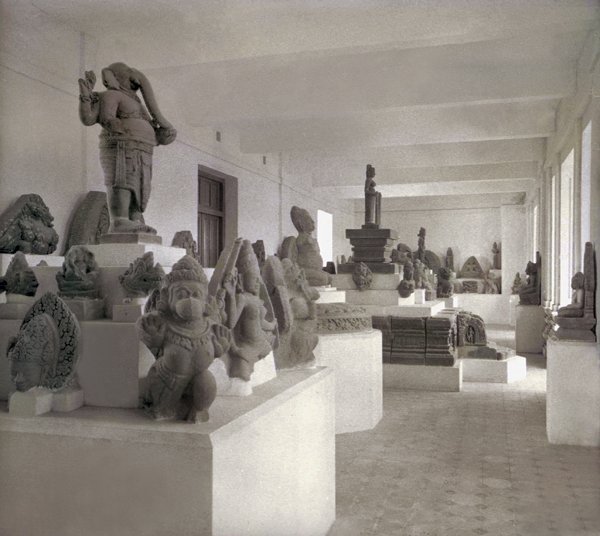The History of Champa
11. Collection in the main room
of the Cham Museum in Tourane, 1922.
Someone visiting Vietnam today, exploring Phan Thiet, Phan Ri and Phan Rang or even Chau Doc, coming across people who are sometimes curiously dressed, would find it difficult to believe that they, the Chams, occupied practically two thirds – in length – of modern Vietnam. In the tenth century, the Khmer Empire and Champa were the main powers of continental South-east Asia, while, to the north, Dai Viet was nothing but a very young kingdom after having been a province of the Chinese Empire for over a thousand years.
Our sources for knowledge of the history of Champa are both textual and archaeological.
For one, there are Chinese and Vietnamese texts (the Annals), the accounts of travellers (from Chinese and Arab to Occidental missionaries and Marco Polo), Cham manuscripts (notably those kept at the Inventory of Archives at the Asiatic Society of Paris), epigraphy (about 210 inscribed stones – written between the fourth and fifteenth centuries at times in Sanskrit, at times in old Cham, sometimes in both languages – have been recorded). Many of them are still waiting to be translated, a complicated task, as it requires a real knowledge of the general history of the country that pure linguists do not have.
There are also archaeological vestiges, the original Cham towers, from Hoa Lai to Chien Dan, from My Son to Po Klaung Garai and so many others, still with us despite the ravages of time and the terrible destruction due principally to the second Vietnam war.
Then one could add to these sources the memory of the Vietnamese Chams, eighty thousand in the provinces of Binh Thuan and Ninh Thuan in central Vietnam, fifteen thousand in Ho Chi Minh City (Saigon) and Chau Doc (An Giang province) close to the Cambodian border, as well as their hundred and fifty thousand “fellow citizens” in Cambodia who survived the barbaric Khmer Rouge. The Chams of central Vietnam are of Brahmanical heritage (Ahirs, or Kaphia or Chuh, Chams), the others follow a particular Muslim cult (Bani Chams). To these two groups must be added the three hundred thousand inhabitants of the High Plateaus who belong to the Austro-Asian language group (Mnongs, Naas and Stiengs) or the Austronesian language group (Jarais, Rhades, Churus, Ra-glais) who participated wholly in Champa’s history, the inhabitants of the plains – those called the Chams – evidently not having been the only inhabitants of the Cham country.
Champa appears in Chinese texts as of the second century. It spread over territories that stretched from north to south, from the Gate of Annam (Hoanh So’n) practically to Ho Chi Minh City (Baigaur in Cham) between the eighth and tenth centuries, and it reached west as far as the Mekong, as witnessed by the Khmer site in Laos, Vat Phu, the stele of Vat Luang Kau or the Prasat Damrei Krap of Mount Kulen in Cambodia, or the expedition led by Doudart de Lagrée that, going through Bassac in 1883 noted that the peoples there still remembered the Chams.
If written proof of the early presence of Chams on the High Plateaus were needed, one could refer to the inscriptions of the Kon Klor temple in the valley of Bla near Kontum that have been dated to 914, that mention the construction by a local chief by the name of Mahindravarman of a sanctuary dedicated to the god Mahindra-Lokesvara, or to other inscriptions such as those of the Yang Prong temple (late thirteenth-early fourteenth centuries), or to the temple of Yang Mum (late fourteenth-early fifteenth centuries)…
The history of the Champa, its beginnings remaining incompletely understood, is made of victories and defeats but also of an inexorable destiny that, of a brilliant and complex civilisation, left only crumbling temples – structures of great originality that are difficult to apprehend – and a decimated and dispersed people. The Chinese Annals report an uprising in 192 AD of people living south of the Chinese command post in Renan (Nhat Nam in Vietnamese), today’s Hue, who founded a state called Lin Yi that began by enlarging toward the north to the Gate of Annam and later encompassed Hindu principalities toward the south. From 192 to 758 the texts always used the term Lin Yi; only in 758 did the name “Huan Wang” come into use. In 875, the entity was designated as “Chiem Thanh”, the Sino-Vietnamese transcription of Champapura or “City of the Chams”.
